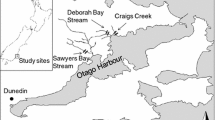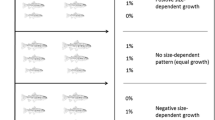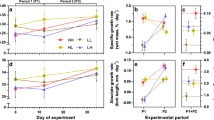Synopsis
Juvenile cichlids, Tilapia zillii, of equal initial standard length were randomly assigned to one of five treatments to assess the relative importance of individual physiological and activity differences, disproportional food consumption, and social interaction on growth depensation and mean growth. Results substantiate the hypothesis that disproportional food acquisition is the primary mechanism responsible for the size hierarchy effect. Individual physiological and activity differences played a negligible role in the phenomenon. Dominant-subordinate relationships, set up in the aquarium, appear responsible for the disproportional food acquisition and thus mediate the size hierarchy effect. Dominant fish ingest more food by either acquiring a limited ration first, preventing a subordinate's food acquisition, or behaviorally inhibiting a subordinate's feeding behavior.
Similar content being viewed by others

References cited
Allee, W.C., B. Greenberg, G.M. Rosenthal & P. Frank. 1948. Some effects of social organization on growth in the green sunfish, Lepomis cyanellus. J. Exp. Zool. 108: 1–19.
Allen, G.R. 1972. The anemonefishes: Their classification and biology. T.F.H. Publications, Neptune City. 288 pp.
Allen, K.O. 1974. Effects of stocking density and water exchange rate on growth and survival of channel catfish Ictalurus punctatus (Rafinesque) in circular tanks. Aquaculture 4: 29–40.
Barlow, G.W., D.H. Bauer & K.R. McKaye. 1975. A comparison of feeding, spacing, and aggression in color morphs of the Midas cichlid. I. Food continuously present. Behaviour 54: 72–96.
Brett, J.R. 1969. Bioenergetics and growth pp. 599–675. In: W.S. Hoar, D.J. Randall & J.R. Brett (ed.) Fish Physiology, Vol. 8, Academic Press, New York.
Brett, J.R., J.E. Shelbourn & C.T. Shoop. 1969. Growth rate and body composition of fingerling sockeye salmon, Oncorhynchus nerka, in relation to temperature and ration size. J. Fish. Res. Board Can. 26: 2363–2394.
Brown, M.E. 1946. The growth of brown trout (Salmo trutta Linn.). I. Factors influencing the growth of trout fry. J. Exp. Biol. 22: 118–129.
Brown, M.E. 1957. Experimental studies on growth. pp. 361–400. In: M.E. Brown (ed.) The Physiology of Fishes, Vol. 1, Academic Press, New York.
Conover, W.J. 1980. Practical nonparametric statistics, 2nd ed. John Wiley & Sons, New York. 493 pp.
Dixon, W.J. & F.J. Massey, Jr. 1969. Introduction to statistical analysis. McGraw-Hill, New York. 638 pp.
Fenderson, O.C., W.H. Evenhart & K.M. Muth. 1968. Comparative agonistic and feeding behaviour of hatchery-reared and wild salmon in aquaria. J. Fish. Res. Board Can. 25: 1–14.
Kawanabe, H. 1969. The significance of social structure in production of the ‘aya’, Plecoglossus altivelis. pp. 243–251. In: T.G. Northcote (ed.) Symposium on Salmon and Trout in Streams, University of British Columbia, Vancouver.
Langlois, T.H. 1936. A study of the small-mouth bass, Micropterus dolomieu (Lacepede) in rearing ponds in Ohio. Ohio Biol. Survey 6: 191–225.
Magnuson, J.J. 1962. An analysis of aggressive behavior, growth, and competition for food and space in medaka (Oryzias latipes (Pisces, Cyprinodontidae)). Can. J. Zool. 40: 313–363.
Nakamura, N. & S. Kasahara. 1956. A study on the phenomenon of the Tobi-Koi or shoot carp. II. On the effect of particle size and quantity of the food. Bull. Japan Soc. Sci. Fisheries 21: 1022–1024.
Nakamura, N. & S. Kasahara. 1957. A study on the phenomenon of the Tobi-Koi or shoot carp. III. On the result of culturing the modal group and the growth of carp fry reared individually. Bull. Japan Soc. Sci. Fisheries 22: 674–678.
Nagoshi, M. 1967. Experiments on the effects of size hierarchy upon the growth of guppy (Lebistes reticulatus). J. Fac. Fish. Prefect. Univ. Mie 7: 165–189.
Pyle, E.A. 1969. The effect of constant light or constant darkness on the growth and sexual maturity of brook trout. Fish. Res. Bull. 31: 13–19.
Rose, S.M. 1960. A feedback mechanism of growth control in tadpoles. Ecology 41: 188–199.
Symons, P.E.K. 1968. Increase in aggression and in strength of the social hierarchy among juvenile Atlantic salmon deprived of food. J. Fish. Res. Board Can. 25: 2387–2401.
Wirtz, P. 1974. The influence of the sight of a conspecific on the growth of Blennius pholis (Pisces, Teleostei). J. Comp. Physiol. 91: 161–165.
Yamagishi, H. 1969. Postembryonal growth and its variability of the three marine fishes with special reference to the mechanism of growth variation in fishes. Res. Popul. Ecol. (Kyoto) 11: 14–33.
Yamagishi, H., T. Maruyama & K. Mashiko. 1974. Social relation in a small experimental population of Odontobutis obscurus (Temminck et Schlegel) as related to individual growth and food intake. Oecologia (Berlin) 17: 187–202.
Author information
Authors and Affiliations
Rights and permissions
About this article
Cite this article
Koebele, B.P. Growth and the size hierarchy effect: an experimental assessment of three proposed mechanisms; activity differences, disproportional food acquisition, physiological stress. Environ Biol Fish 12, 181–188 (1985). https://doi.org/10.1007/BF00005149
Received:
Accepted:
Issue Date:
DOI: https://doi.org/10.1007/BF00005149



